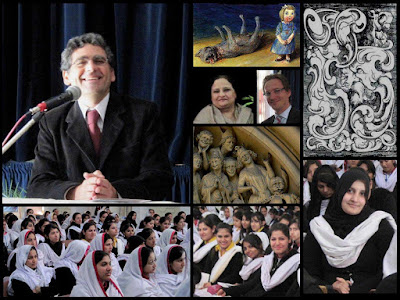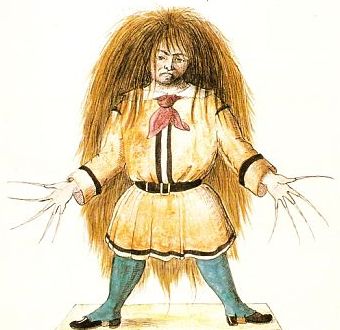
An educational lecture, "The Grotesque in German Art" is part of Shape and Meaning, a program of educational lectures on the German contribution to the visual arts. Aiming to bridge cultures and people, this extraordinary program counts with the kind support of the German Embassy in Islamabad.

Today a new lecture was given at the Islamabad College for Girls, where lecturer Mariano Akerman met 380 Pakistani students.

Conceived and organized by Art Historian Mariano Akerman in collaboration with the cultural attache of the German embassy, Thomas Ditt, the event was verbally described by a student as "awesome."
Prof. Rabya Qadir once again gathered a great number of students and teachers from her College. They followed attentively the lecture to later ask no less than seven questions which not only were pertinent to the topic discussed but also brilliant in their nature, this being so mostly due to their engagement along the lecture and remarkable curiosity at the time of confronting the Grotesque face to face.
Mariano Akerman explored and analized two dozens of Grotesque artworks, including those important German masters such as Conrad von Megenberg, Hartman Schedel, Albrech Dürer, Christoph Jamnitzer, Simon Cammermeir, Johann Heinrich Keller, Jeremias Waschmuth, Carl Strathmann, Max Ernst, Meret Oppenheim, Thomas Grunfeld, and Ernst Kahl.
Students and teachers were interested in the interplay reality and grotesqueness. They wanted to know the function and raison d'être of the grotesque in art and whether it can be considered visionary art. They asked whether the grotesque can be seen as some sort of irony.
The event was no doubt much appreciated and even prized by the public. Bunches of flowers and numerous writen comments were handled to Ditt and the lecturer. It was a fine day in Islamabad and shining wasn't just the sun here, for today we actually had several. The day was wonderful. Simply put, unforgettable.


Event brochure
The Grotesque in German Art - Highlights

Bamberg cathedral, Princes' Portal, tympanum: portion of the Last Judgement showing the Damed (being taken to hell by a devil), 1235

Green-Man Keystone at Bamberg cathedral

Hartmann Schedel, The Monstrous Races: "Blemmyae," from Liber chronicarum (Die Schedelsche Weltchronik, Das Buch der Croniken und Geschichten von Hartmann Schedel), woodcut, 1493. The Blemmyae were believed to live somewhere between Africa and India (Pliny, Natural History, 57-58).

Michael Wolgemut, "Dance of Death" (Totentanz), from Hartman Schedel's Liber chronicarum, woodcut, 1493

Hans Holbein the Younger, The Rich Man, woodcut, detail, 1523-26

Christoph Jamnitzer, Neuw Grotteßken Buch (New Book of Grotesques), Nuremberg 1610

Friedrich Unteutsch, Gristly Motif (Knorpelwerk), engraving, 1650

Johann Heinrich Keller, Cartilaginous Grotesque (Knorpelgrotesk), engraving, 1680

Johann Georg Hertel (after Jeremias Wachsmuth), Winter, Rococo Music, Fancy Dress Ball, etching, 1750-60

Death and Soap Bubbles, stucco relief, 18th century. Michelsberg Cloister, Bamberg

Heinrich Hoffmann, Slovenly Peter (Der Struwwelpeter), Baden, 1858.

Meret Oppenheim, Object (Breakfast in Fur), 1936

Max Ernst, She looked a little bit like a horse, collage, 1937

And silence is made, ad from a beer company, c. 1996

Ernst Kahl, The Fighting Dog (Der Kampfhund), on the cover of In the refrigerator light still burns (Im Kühlschrank brennt noch Licht), record, 1996. Kahl, a musician, is also the author of Bestiarium Perversum (1985). On Kahl, see Matthias Wagner, "Komik ist Notwehr" (Comedy is Self-defense), Kulturnews, May 1997.
• Remarks by Prof. Sabah Faisal: "Attending Mr. Akerman's lectures was very interesting not only for their content but also for the passion he puts in them to explain the subject matter to the audience--serious facts interspersed with some personal opinion and a touch of humour, making an appealing mix that keeps the audience's attention riveted.
His first lecture gave us a view of how to look at a picture and learn from it, while the second one was enlightening. Introducing the students to grotesque of art helps in broadening their vision and making them understand different facets of life. Today's lecture on Grotesqueness at ICG F-6/2 gave us an in depth perception of German art. It was a mind opening experience, captivating and mesmerized us from start till end. It gave us food for thought about the harsh realities of life in contrast to fairy tales. We really are mesmerized by the swiftness and flow of the German lectures given by Mariano Akerman and are looking forward to more in the series. As the lecturer himself made it clear today, the grotesque invites a search for meaning, pushing us to consider alternative possibilities. Grotesque art is thought-enlarging art; it has an immense capacity to open the valves of feeling."
Double-Edged, clip on grotesqueness in the visual arts, 2008. Featured: French Medieval hybrid; Giuseppe Arcimboldo; Italian Renaissance grotteschi (sogni dei pittori); Francis Bacon; Quentin Metsys; Keller; Quino; Roman Domus Aurea; Paul-Andreas Weber. DOUBLE-EDGED 1. Having two edges that can be used; having two cutting edges. 2 Having a dual purpose; having two meanings; effective or capable of being interpreted in two ways. Double-edged sword - literally, a sword which cuts on either side; metaphorically, an argument which makes both for and against the person employing it, or which has a double meaning. Shape and Meaning: The German Contribution to the Visual Arts - Five Educational Lectures by Mariano Akerman, German Embassy Islamabad, 3.1.2011, Education & Culture
Shape and Meaning: The German Contribution to the Visual Arts - Five Educational Lectures by Mariano Akerman, German Embassy Islamabad, 3.1.2011, Education & Culture  Deutsche Kunst - Form und Bedeutung. Eine Vorlesungsreihe von Mariano Akerman, Botschaft der Bundesrepublik Deutschland, Islamabad, 3.1.2011, Kulturelle Beziehungen (Andreas Dauth). Selected masterpieces at the German Art Gallery
Deutsche Kunst - Form und Bedeutung. Eine Vorlesungsreihe von Mariano Akerman, Botschaft der Bundesrepublik Deutschland, Islamabad, 3.1.2011, Kulturelle Beziehungen (Andreas Dauth). Selected masterpieces at the German Art Gallery
His first lecture gave us a view of how to look at a picture and learn from it, while the second one was enlightening. Introducing the students to grotesque of art helps in broadening their vision and making them understand different facets of life. Today's lecture on Grotesqueness at ICG F-6/2 gave us an in depth perception of German art. It was a mind opening experience, captivating and mesmerized us from start till end. It gave us food for thought about the harsh realities of life in contrast to fairy tales. We really are mesmerized by the swiftness and flow of the German lectures given by Mariano Akerman and are looking forward to more in the series. As the lecturer himself made it clear today, the grotesque invites a search for meaning, pushing us to consider alternative possibilities. Grotesque art is thought-enlarging art; it has an immense capacity to open the valves of feeling."
Double-Edged, clip on grotesqueness in the visual arts, 2008. Featured: French Medieval hybrid; Giuseppe Arcimboldo; Italian Renaissance grotteschi (sogni dei pittori); Francis Bacon; Quentin Metsys; Keller; Quino; Roman Domus Aurea; Paul-Andreas Weber. DOUBLE-EDGED 1. Having two edges that can be used; having two cutting edges. 2 Having a dual purpose; having two meanings; effective or capable of being interpreted in two ways. Double-edged sword - literally, a sword which cuts on either side; metaphorically, an argument which makes both for and against the person employing it, or which has a double meaning.
 Shape and Meaning: The German Contribution to the Visual Arts - Five Educational Lectures by Mariano Akerman, German Embassy Islamabad, 3.1.2011, Education & Culture
Shape and Meaning: The German Contribution to the Visual Arts - Five Educational Lectures by Mariano Akerman, German Embassy Islamabad, 3.1.2011, Education & Culture  Deutsche Kunst - Form und Bedeutung. Eine Vorlesungsreihe von Mariano Akerman, Botschaft der Bundesrepublik Deutschland, Islamabad, 3.1.2011, Kulturelle Beziehungen (Andreas Dauth). Selected masterpieces at the German Art Gallery
Deutsche Kunst - Form und Bedeutung. Eine Vorlesungsreihe von Mariano Akerman, Botschaft der Bundesrepublik Deutschland, Islamabad, 3.1.2011, Kulturelle Beziehungen (Andreas Dauth). Selected masterpieces at the German Art Gallery





23 comments:
A very informative lecture. Enterteining and amusing as well. I highly appreciate your work. Looking forward for more, I wish you all the very best for the future.
All the chosen pictures are fantastic. Some are strange yet tell us something about the artists' ways of thinking and feeling.
Thank you so much for the lovely lecture. It was nicely presented. I enjoyed it a lot.
Today I've learnt that the artistic grotesque can be nice yet ugly. Kind of soursweet. German people have a good sense of humour. I really like the lecture. It was informative and inspiring.
It was a great pleasure to get knowledge about German art. The lecturer's presentation and answers were very satisfactory. The whole session is most appreciated.
The grotesque produces uncertainty and confusion. It puts a question mark in our minds. Yet we got familiar with the unfamiliar. It was a very informative dialogue.
German artists love extraordinary things. Meret Oppenheim's Objet: the cup will keep the tea warm while the fur coat is to keep the cup itself warm. The grotesque catches my attention and chills up my spine.
The lecture broadened our view about German art. Grotesque art is something wonderful and pushes one to think about unexpected things. I really enjoyed Mr. Akerman's lecture.
The lecture was entertaining and very informative, being delivered in a most interesting way. It was a pleasure attending it.
The lecture opened a new perspective into the arts field.
Thank you so much!
I was never interested in art, until I listened to you. Thank you for enlighten us.
The lecture was great and we enjoyed it from the very begining. Dr. Thomas' smile is nice, and Prof. Mariano's lecture was the best lecture I have ever taken.
Really impressive and lessonful. Friendly. Adorable.
A marvelous lecture. Thank you so much.
A very impressive topic and great inspiration. Now we know the real meaning of the grotesque. Thanks
Everything, and even the most confusing, was explained very clearly.
It was a pleasure attending to such an informative and above all most enjoyable lecture.
A very informative and well presented lecture. Very useful for all students. I wish you all the very best for the future.
I never took any interest in fine arts. Before entering the auditorium today, I had no idea that I was going to develop a life-long interest in fine arts, which your informative and wonderful lecture has aroused in me. This is a miracle. The miracle of your lecture.
This was the most outstanding lecture that I ever had in my life. Very informative indeed. I got almost every part of the Grotesque thanks to you. And, because of that, I grew interest in it.
The lecture you delivered at Islamabad College for Girls on The Grotesque was very enlightening for both the Fine Arts students and English Literature students. I especially enjoyed it a lot. Being a teacher of Blake and the other Romantic poets I could easily relate it with my subject. Thanks for giving us the honour of hosting your lecture in our college.
Es fantástico. Comprendo muy bien de que amas el país donde vives y su gente. A seguir con tus trabajos maravillosos por la humanidad. Y sobre todo, sigue inspirando la gente.
Post a Comment